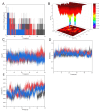Uridine, a Therapeutic Nucleoside, Exacerbates Alcoholic Liver Disease via SRC Kinase Activation: A Network Toxicology and Molecular Dynamics Perspective
- PMID: 40564937
- PMCID: PMC12193447
- DOI: 10.3390/ijms26125473
Uridine, a Therapeutic Nucleoside, Exacerbates Alcoholic Liver Disease via SRC Kinase Activation: A Network Toxicology and Molecular Dynamics Perspective
Abstract
This study looked into the underlying mechanisms and causal relationship between alcoholic liver disease (ALD) and the blood metabolite uridine using a variety of analytical methods, such as Mendelian randomization and molecular dynamics simulations. We discovered uridine to be a possible hepatotoxic agent aggravating ALD by using Mendelian randomization (MR) analysis with genome-wide association study (GWAS) data from 1416 ALD cases and 217,376 controls, as well as with 1091 blood metabolites and 309 metabolite concentration ratios as exposure factors. According to network toxicology analysis, uridine interacts with important targets such as SRC, FYN, LYN, ADRB2, and GSK3B. The single-cell RNA sequencing analysis of ALD tissues revealed that SRC was upregulated in hepatocytes and activated hepatic stellate cells. Subsequently, we determined the stable binding between uridine and SRC through molecular docking and molecular dynamics simulation (RMSD = 1.5 ± 0.3 Å, binding energy < -5.0 kcal/mol). These targets were connected to tyrosine kinase activity, metabolic reprogramming, and GPCR signaling by Gene Ontology (GO) and KEGG studies. These findings elucidate uridine's role in ALD progression via immunometabolic pathways, offering novel therapeutic targets for precision intervention. These findings highlight the necessity of systems biology frameworks in drug safety evaluation, particularly for metabolites with dual therapeutic and toxicological roles.
Keywords: alcoholic liver disease; mendelian randomization; molecular dynamics simulation; network toxicology; single-cell RNA sequencing.
Conflict of interest statement
The authors declare that they have no competing interests.
Figures







Similar articles
-
Phytochemical Analysis of Semen Hoveniae and Its Potential Mechanism Against Alcoholic Liver Disease via an Integrated Approach Combining UHPLC-Q-TOF MS, Network Pharmacology, and Molecular Docking.Rapid Commun Mass Spectrom. 2025 Oct 30;39(20):e10097. doi: 10.1002/rcm.10097. Rapid Commun Mass Spectrom. 2025. PMID: 40589271
-
Understanding mechanisms of Polygonatum sibiricum-derived exosome-like nanoparticles against breast cancer through an integrated metabolomics and network pharmacology analysis.Front Chem. 2025 Jun 6;13:1559758. doi: 10.3389/fchem.2025.1559758. eCollection 2025. Front Chem. 2025. PMID: 40547857 Free PMC article.
-
Systemic pharmacological treatments for chronic plaque psoriasis: a network meta-analysis.Cochrane Database Syst Rev. 2021 Apr 19;4(4):CD011535. doi: 10.1002/14651858.CD011535.pub4. Cochrane Database Syst Rev. 2021. Update in: Cochrane Database Syst Rev. 2022 May 23;5:CD011535. doi: 10.1002/14651858.CD011535.pub5. PMID: 33871055 Free PMC article. Updated.
-
Immunogenicity and seroefficacy of pneumococcal conjugate vaccines: a systematic review and network meta-analysis.Health Technol Assess. 2024 Jul;28(34):1-109. doi: 10.3310/YWHA3079. Health Technol Assess. 2024. PMID: 39046101 Free PMC article.
-
Non-invasive diagnostic assessment tools for the detection of liver fibrosis in patients with suspected alcohol-related liver disease: a systematic review and economic evaluation.Health Technol Assess. 2012;16(4):1-174. doi: 10.3310/hta16040. Health Technol Assess. 2012. PMID: 22333291 Free PMC article.
References
-
- Song H., Zhou H., Yang S., He C. Combining mendelian randomization analysis and network toxicology strategy to identify causality and underlying mechanisms of environmental pollutants with glioblastoma: A study of Methyl-4-hydroxybenzoate. Ecotoxicol. Environ. Saf. 2024;287:117311. doi: 10.1016/j.ecoenv.2024.117311. - DOI - PubMed
MeSH terms
Substances
Grants and funding
LinkOut - more resources
Full Text Sources
Miscellaneous

